


1st Battalion, 20th Engineers
The First Battalion
Note: Most of the text of this article comes from "TWENTIETH ENGINEERS -- FRANCE -- 1917-1918-1919"
Organization of the Twentieth Engineers was initiated by the authorization of the First and Second Battalions August 28th, 1917. Actual recruiting for the regiment was launched at the same time, and the company units began to form, with a nucleus of men left behind by the Tenth Engineers when they started overseas September 9th. The First Battalion occupied the barracks vacated by the corresponding companies of the Tenth on the western street of Camp American University.
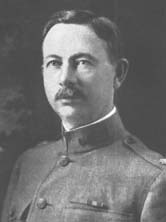
Major Edward E. Hartwick, commander of 1st Battalion, 20th Engineers until his death from illness in March of 1918
Click on the photo to read an article by Major Hartwick
Original plans called for a battalion strength of 600 men. This was increased, September 28th, to 800, in line with the revised schedule for line troops adopted by the War Department to bring our military units into groups corresponding to those of our chief allies. Under the new schedule the First Battalion did not reach strength until along in October. Recruits arriving after that were placed in casual companies, attached to the First and Second for rations, and eventually formed into the Third Battalion.
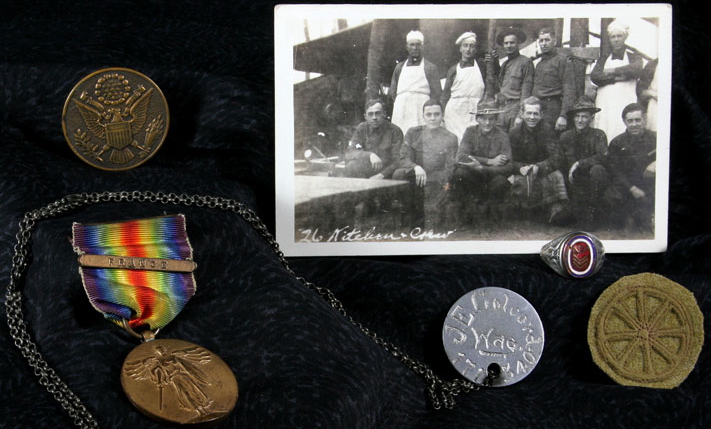
Private 1st Class Josiah E. Colcord was a wagoneer in Company A, 1st Battalion.
Click the image for more information about him, plus photos of items from his military service.
September and October were spent in primary training--close order drill, interior guard, and physical exercise. It is noteworthy, and characteristic of the entire regiment, that at no time was any attempt made to school recruits in any of the anticipated forestry duties. The high degree of skill brought from civilian life by the men of the Tenth and Twentieth made any instruction along this line entirely unnecessary.
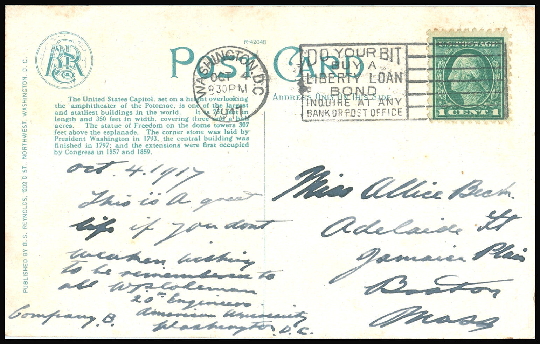
Postcard from W. P. Coleman of Company B, 20th Engineer Regt
"This is a great life if you don't weaken."
With the officers, of course, the problem was acute, and more than one company commander made valiant but unavailing efforts to replace his subordinates with junior of ricers from whom he could expect practical assistance in mills, woods, yard or railway activities.
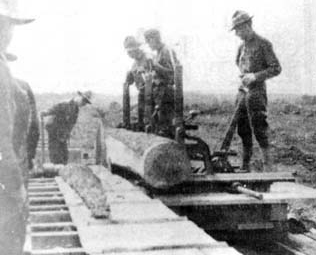
The last month in the States was marked by daily expectation of sailing orders. Equipment was slow in arriving, and it was not until the second week of November that the coveted orders were promulgated. Vacancies in the ranks were filled by a draft from the Third Battalion, and finally, November 11th, 1917, our first two battalions left University Camp, in heavy marching order, and entrained for New York.
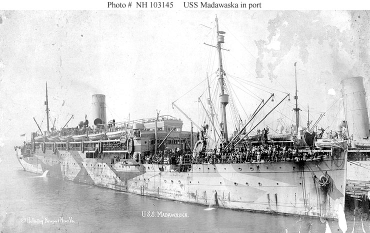
USS Madawaska
The next evening they boarded the U. S. S. Madawaska, which had been the German liner "Konig Wilhelm II." The vessel was convoyed across by the cruiser "San Diego" and two destroyers. The troops were debarked at historic St. Nazaire, November 28th, and marched to the American Camp, where three weeks were spent in lining out the companies and their equipments for their various stations.
The maritime pine forests of the Landes, on the shore of Biscay in southwestern France, had been selected as an American forestry district; the First Battalion of the Tenth Engineers already were on the ground at Pontenx, in the northern part of the region. It fell to the lot of the First Battalion Headquarters to install a new district organization at Dax, forty miles further south. Co.s A and C, of the First, and detachments of Co. F of the Second, were assigned to the Dax District. Co. B (later 30th Company) was detached from the Battalion organization and ordered to central France, where it operated under the 10th Battalion in the Bourges District.
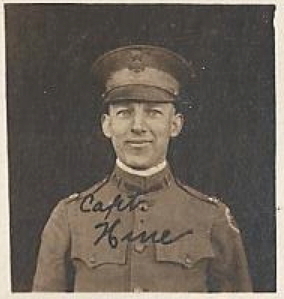
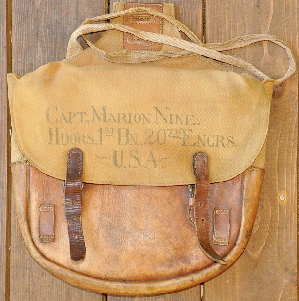
A musette bag belonging to Captain Marion Nine. As a lieutenant, Nine was assigned to Company F, Second Battalion. At some point Nine was assigned to the First Battalion headquarters. By the end of the war, Nine was the Commander of 2nd Company. Before and after the war, he was owner and operator of the Marion Nine Lumber Company in Nine, Calif.
The District headquarters organization was billeted in the city of Dax, which is a picturesque town of Roman origin, some 30,000 population. The Spanish border is only 30 miles to the south, and this proximity gives rise to several Spanish characteristics, the most apparent of which is a huge bull-ring or arena, on the bank of the Adour River at the edge of the city. The spectacles were under a strict ban during the war, and the comptrollers of the arena offered its use to the American troops. Here the District offices, supply depots, shops and barracks were installed. A messhall was built in the center of the other structures grouped outside.
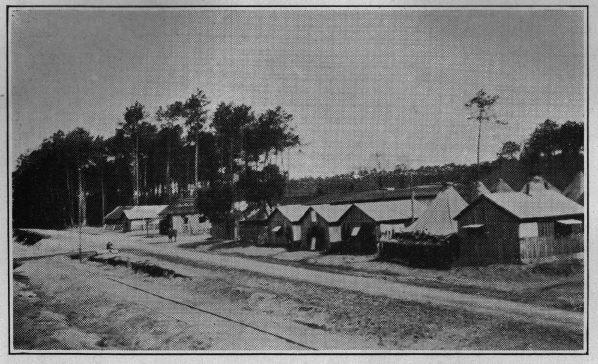
The camp of Company C, 1st Battalion (3rd Company)
The companies were assigned to lumber projects centering on Dax. Co. A, which under revised designations became the First Co. Twentieth Engineers, had arrived at Dax Dec 22nd, and immediately commenced construction of a camp at Mees, some five miles southeast of town. They built and operated a mill of rated 20,000 foot capacity, with a large, compact body of pine timber to draw upon. Co. C, the Third Co., was assigned to the locality of Candale, three miles farther out, on a branch line of the Midi Railroad leading into Dax. Here also a 20-M mill was built, with logging lines of 2 foot decauville track.
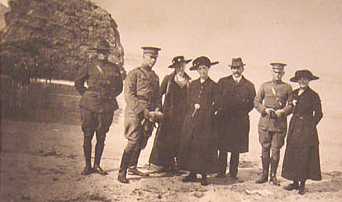
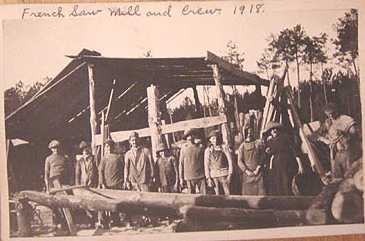
Photos from 1st Company (Company A, 1st Battalion), 20th Engineers
The Third Co. lays claim to having stayed on the job in one place longer than any other of all the 49 companies. With the exception of a cleanup detail of 50 men sent to Mees after the Armistice, no breaks in the 15 months of duty occurred at Candale. The First Co. were less stable, being shifted to Arengosse, twenty five miles to the northeast. The Mees operation was then taken over by a detachment of the Second Co. (F of the Second).
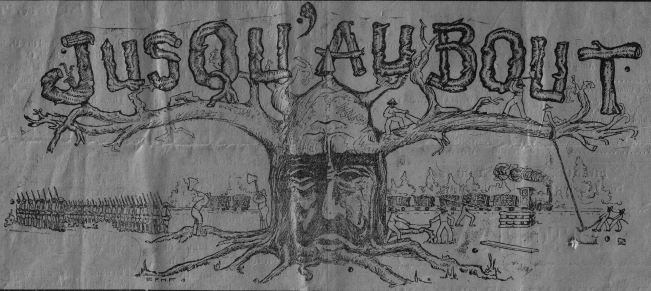
Companies A and C of 1st Battalion published a newspaper "somewhere in France" named Jusqu'au Bout (To The End, or more probably Until It's Over). Note the banner shows a tree whose trunk resembles Kaiser Wilhelm, with foresters working to take it down. Also shown are stacks of lumber and ties, a train pulling timbers, and files of marching doughboys. Click on the photo to see more images of the paper.
The First Christmas at Dax was observed was a holiday--destined to be the last holiday for a long long time. Through the courtesy of local impresarios the moving picture palace of Dax was thrown open to the Americans, who were paraded into town, and out again before the insidious power of the buvettes could do their deadly work.
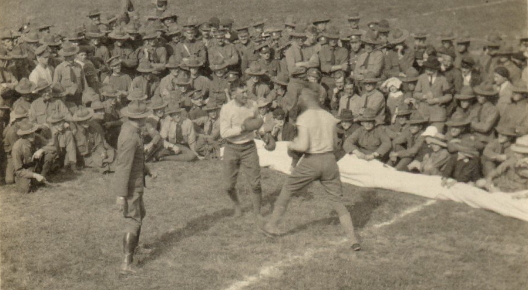
A boxing match at Dax, on the 4th of July, 1918
During the summer of 1918 the district strength was augmented by the arrival of the Sixteenth Service Co. (Colored) who were assigned to the Arengosse camp. In May a new district was installed at Castets, fifteen miles north, by the Sixth Battalion. The pine forests of the vicinity also harbored several units of the Canadian Forestry Corps, who maintained administrative offices in Dax.

After the Armistice, though the battalion was still very busy, there was a little more time for non-combat operations. The battalion was entertained in a number of ways, one of which was "What Next? An Impromptu Frolic." Click on the image to see the program from the play.
After the Armistice the logging operations were brought to an orderly conclusion, and all preparations made for orderly departure, when the First Battalion meathouse was pulled down by the reversal of policy of Hq., S. O. S. With a fair degree of reluctance the outfits turned their calloused hands to road making, and were deeply immersed in the concoction of waterbound macadam when orders finally came for return to the States.
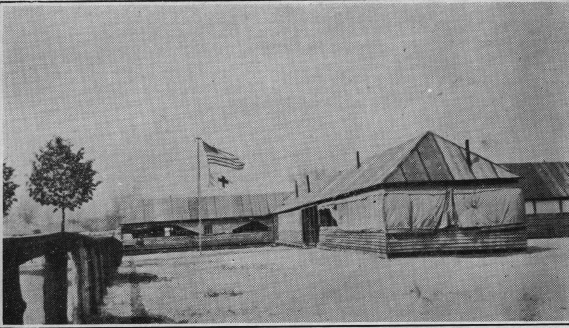
The Hospital at Dax
The complete equipment of the Dax District--camps, mills, rollingstock--was taken over by the headquarters detachment of the Fourth Battalion, March 20th, 1919. The next day First Headquarters, the 1st, 2nd, and 3rd Co.s left for the Bordeaux embarkation area. Here they were joined by the 5th Co. After two weeks at Genicourt they marched to Bassens and boarded the transport "Roanoke," which had served as a minelayer in the North Sea during the war.
The "Roanoke" was not roomy, and an outbreak of the mumps proved hard to check, so that a considerable number of the outfit served a hitch of quarantine after landing. With their exception the last of the Dax contingent were on their way to home cantonments by the first of May. The landing was at Hoboken, April 18th, 1919.
Co. B of the First Battalion left the rest camp at St. Nazaire ahead of the Dax contingent, and spent two days on a slow train through Vendee, arriving at their permanent station, Mur-de-Sologne, a village twelve miles from Gievres, in the Department of Loir-et-Cher. Gievres was later destined to be one of the largest supply depots of the A.E.F., but at this time the budding camp held less than 1000 men. To this camp Co. B was required to furnish a small detail to handle forestry supplies. The detail was temporary, but a stray wisp of red tape reached out and snared the detachment, and it was fifteen months ere they were restored to their command.
The company erected a mill of 10,000 capacity, operating double shift, a furnishing a good part of the structural timbers required in the Gievres development. Four months after their arrival, forestry activities were increased by the arrival of the 10th Battalion and the creation of the Bourges District, in which Co. B was incorporated. This change led to the unit being designated the 30th Co.
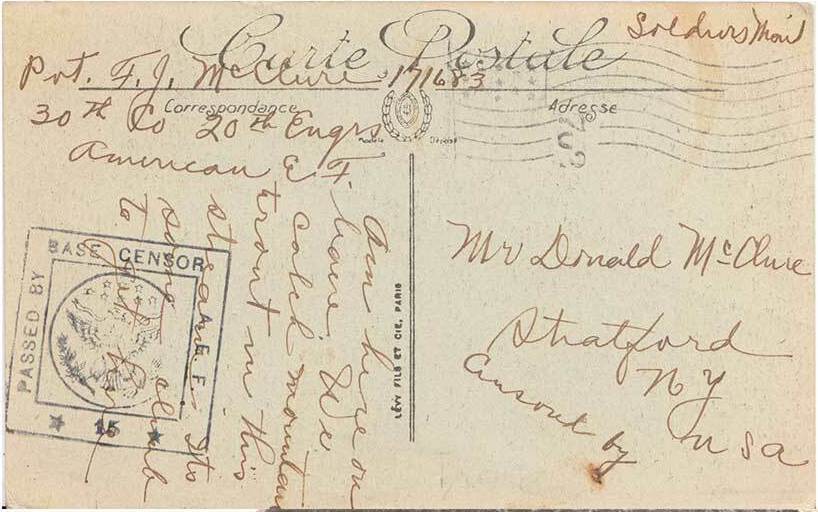
Postcard from Private F. J. McClure, 30th Company. Note censor stamp.
In several respects the 30th Co. enjoyed advantages denied most of the forestry troops. Leave privileges were granted in accordance with A.E.F. regulations; a company band was formed and maintained; dances, to which the local belles were invited, gave the outfit a sensation of being among friends.
Twice during the month of December, 1918, the unit was ordered to prepare for embarkation. The second time, cars were already spotted for entraining, when orders were reversed, and the company assigned to road construction near Tours. A month was spent at this thankless pursuit, when one more task was dealt out. The outfit was ordered to Lamanchs, in the Mimizan District of the Landes, where they arrived the first or March, built a camp, and, upon the departure of the 11th Co. for Dax a few days later, took over the big mill and resumed sawing of standard ties into inch lumber. Six weeks later the company was finally released from duty and struck for Bordeaux.
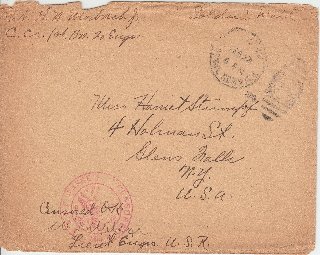
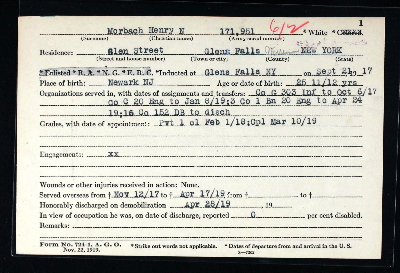
Corporal Henry N Morbach - Service card and envelope from a letter home
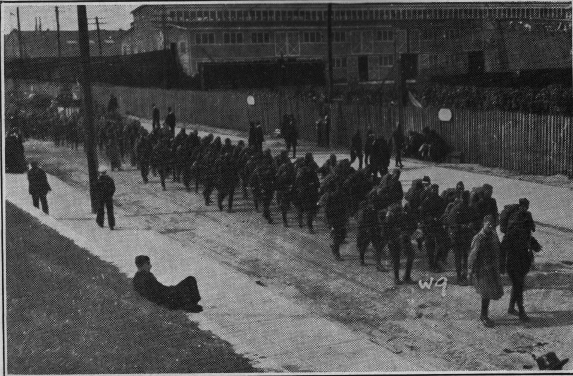
30th Company (Company B, 1st Battalion) after debarking at Newport News
The First Battalion was perhaps the most cosmopolitan of our units. Every state and
territory was represented, and in well balanced proportions. Its strength was recruited by
a vigorous campaign nationwide in extent, and no very large increments were drawn from any
one section of the country.
Officers of 1st Battalion, 20th Engineers:
Battalion Commander - Major E. E. Hartwick
Engineer Officer - Captain H. B. Campbell
Adjutant - Captain Leon M. Pill
Supply Officer - First Lieutenant L. J. Freedman
Attached - Captain F. M. Bartelme, Regimental Engineer Officer
Company A (1st Company)
Company Commander - Captain Arthur W. Elam
First Lieutenants - Germain P. Graham, Duncan P. Shaw and James C. Williams
Second Lieutenants - John B. Cuno and Roy L. Chaffin
Company B (30th Company)
Company Commander - Captain Robert A. Cutting
First Lieutenants - Harold C. Lyons, William A. Clark and Thomas W. Poindexter
Second Lieutenants - Arthur N. Dripps, Cecil B. Bradley and Angus I. Ward
Company C (3rd Company)
Company Commander - Captain H. W. Boetzkec
First Lieutenants - R. N. Benjamin, W. J. Wilson and J. Leroy Wood
Second Lieutenants - Hollister Johnson and H. T. Hopkins
Medical Detachment
First Lieutenants - Robert B. Hill, M. D., Lloyd A. Elliott, M. R. C, and Charles P. Hatrick, D. R. C.
Second Lieutenant - Julius A. Herbott, V. R. C.